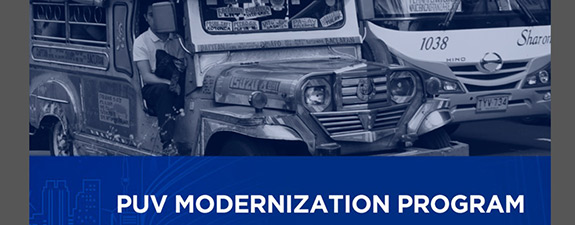
PUV Modernization – A transformational large-scale initiative and flagship project of President Duterte supported by the proposed Comprehensive Tax Reform Program of the Department of Finance. It envisions a restructured, modern, well-managed, and environmentally sustainable transport sector where drivers and operators have stable, sufficient, and dignified livelihoods while commuters get to their destinations quickly, safely, and comfortably.
Main Objectives:
1. Modernize the current PUV fleet.
2. Reform and consolidate the industry
3. Move towards low emission PUVs
4. Improve welfare of commuters and encourage modal shift
5. Improve standards of living of drivers, operators and their families
Benefits
Reliability
• Predictable in terms of travel time, waiting time and schedule.
• Commuters will benefit from a fixed dispatch time and short intervals between vehicles during peak demand periods
• Commuters need not wait long for the PUV to arrive
• Operating hours shall be responsive to the needs of visitors, nights students and workers who require late night travel.
Safety
• Vehicles shall comply with national standards and international vehicle
safety conventions
• Relevant vehicle parts shall be compliant with PNS
• Boarding or alighting from PUB+Vs in undesignated stops is
fundamentally unsafe
• Bus stops shall be adequately lit at night for security
• PUVs must be equipped with extinguishers
• Pursuant to RA 10916 or the Road Speed Limiter Act of 2016
• CCTVs shall be installed to monitor activity in and around the vehicle
• Global Navigation Satellite System (GNSS e.g. GPS) shall be installed to enable recording of vehicle location and speed and sharing or real-time PUV information
• For all PUVs, windshield and windows shall not be tinted.
Accessibility
• Public transport must be available in every community with accessibility for all segments of society, including senior citizens and PWDs
• Access shall include good walkways and bikeways to provide connectivity with other modes of transportation
• Designated location of stops, pick-up, and drop-off points with adequate facilities to facilitate convenient boarding and alighting of passengers.
Environmental Soundness
• PUVs with combustion engines must have low emissions, as proven by compliance with EURO IV emission standards or better (e.g. EURO V, EURO VI), as prescribed by the DENR
• Other preferred public transport vehicles are those using electric drives and/or running on alternative fuels, such as electric or solar
Comfort
• Vehicle is fitted with comfortable seats where passengers are able to relax, rest, and be productive during the journey
• Provision of Wi-Fi access
• For buses that permit standing passengers, the number of standing passengers must not exceed five (5) persons per square meter of the available standing space.
Major Components
1.Regulatory Reform
2.LGU Local Public Transport Route Planning
3.Route Rationalization
4.Fleet Modernization
5.Industry Consolidation
6.Financing PUV Modernization
7.Vehicle Useful Life Program
8.Initial Implementation
9.Stakeholder Support Mechanism
10.Communication
Regulatory Reform – DOTr Department Order 2017-11: Omnibus Franchising Guidelines (OFG)
• New LTFRB guidelines on franchise issuance for road-based public transportation services.
• DOTr/ LGUs: Local public transport route planning & route rationalization.
• Modernized PUV fleet compliant with safety & environmental laws/ standards.
• Fleet/Industry consolidation for efficient operations.
Hierarchy and Classification of Public Transport Modes
1. The modes of transportation shall follow the hierarchy of roads.
2. Higher capacity transport modes shall have priority in terms CPC allocation and transit right of way in trunk lines or main thoroughfares over lower capacity modes.
3. Taxis, TNVS, tourist transport services and shuttle services are excluded as they are considered as door-to-door services and do not have specific routes.
4. As a general rule, assigning higher capacity modes to routes currently traversed by lower capacity modes in the Local Public Transport Route Plan may be allowed, but not otherwise.
5. Operation of tricycles shall be in accordance with JMC No.1, s. of
2008 of the DILG and the DOTC
6. Tricycle operations should only be confined along city or municipal roads, not along national roads and is limited only to routes not traversed by higher modes of public transport
7. Motorcycles and other farm implements such as kuliglig are not allowed as public conveyance.
Signed Memorandum Circulars: 7
1. Maximum Distance Policy
2. Responsibilities and Selection of Transport
Safety Officers
3. Garages
4. Off-Street Terminal Operations
5. Guidelines for Intra-Regional, Inter-Regional, and
Inter-Provincial Public Transport Route Plans
6. Initial Implementation
7. Industry Consolidation
To be continued…
